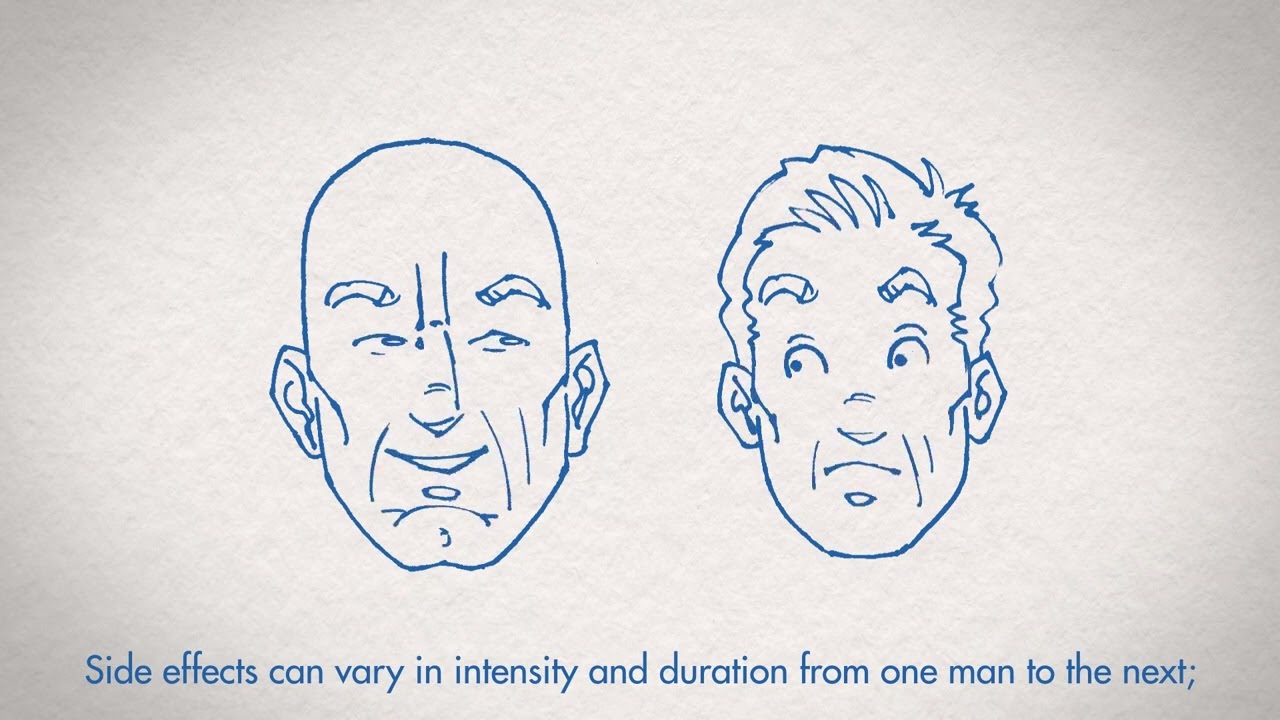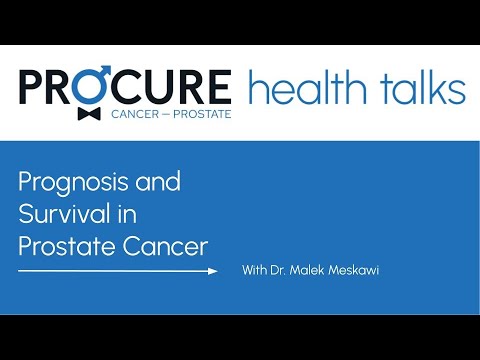Prognosis and survival
- Prostate cancer
- Prognosis and survival
- Outlook
- Predictive tools
- Managing your expectations
Prognosis and survival
What is a prognosis?
A prognosis is an estimation made by a doctor regarding the course of the disease, the patient’s health status, reactions to treatment, as well as the chances of recovery and/or survival. Many factors are taken into account when establishing a prognosis for prostate cancer.
No one can predict exactly what will happen to you. However, your doctor or nurse may give you an idea based on the experiences of other men who have had similar cancer.
On this page, you will discover your outlook based on the type of your cancer: localized, locally advanced, or metastatic at the time of diagnosis. You will also learn more about the prediction tools that your doctor may use to anticipate different short-term or long-term outcomes.
If you have any questions or concerns, feel free to contact us at 1-855-899-2873 or via chat to discuss with one of our healthcare professionals specialized in uro-oncology.
After receiving your diagnosis for prostate cancer, it is natural to imagine the worst and worry about how cancer will affect your life and the lives of your loved ones. It can be difficult and stressful to have to decide on your treatment. You will most certainly have questions regarding your prognosis and may want to know what the chances are for a successful treatment.
Unfortunately, no one can tell you exactly what your outlook will be since many factors come into play: the stage of your cancer, the speed at which your cancer is spreading, your age, your general health, and any other health problems. However, it is important to note the following:
Localized prostate cancer
- In most cases, this cancer is slow-growing and does not affect your lifespan.
- In many cases, the primary treatment will get rid of the cancer.
- In some cases, the cancer can be aggressive, evolve more quickly and spread elsewhere in the body.
- In some cases, the cancer recurs after the primary treatment and other treatments become necessary.
Locally advanced prostate cancer
- In many cases, the primary treatment aims to eliminate the cancer.
- Treatment may involve a combination of therapeutic approaches.
- In some cases, the cancer recurs after the primary treatment and other treatments become necessary.
Metastatic prostate cancer
- This cancer cannot be cured.
- Hormone therapy can be effective in keeping your cancer under control for many years.
- Depending on its spread in the body, dual or triple therapy may be considered (e.g., standard hormone therapy + chemotherapy + next-generation hormone therapy).
- Developing resistance to hormone therapy calls for further treatments, often in combination.
- Treatments can also relieve pain and symptoms related to metastases.
Prognostic factors
A prognosis is a hypothesis put forth by a doctor regarding the progression of the disease, health changes in the patient, reaction to a treatment, and chances of recovery. Different factors are taken into account when the time comes to determine a prognosis for prostate cancer.
Age
The age of a person at the time of diagnosis is a determining factor in the prognosis of prostate cancer. The general life expectancy of the population is taken into account – an older man may be at risk of significant health problems from potential treatments. It is also important to know that prostate cancer appearing at a younger age can prove to be more aggressive.
Associated diseases (Comorbidities)
The presence of other medical conditions can have an effect on life expectancy. For example, diabetes, cardiovascular diseases, respiratory diseases, or other malignant tumours , depending on their severity, the prognosis and chosen therapeutic approach may vary.
Clinical stages
The earlier cancer is diagnosed, the smaller the tumour is, and the more localized within the prostate it is (stage T1 and T2); the more favourable the prognosis.
Gleason grade or score
The higher the Gleason grade or score is, the less favourable the prognosis.
Prostate-specific antigen test (PSA)
The higher the PSA level is, the less favourable the prognosis.
Prognostic grouping of prostate cancer
TNM prognostic grouping for prostate cancer is based on the stage, PSA level and Gleason score. This grouping is more accurate in predicting a prognosis than TNM staging alone. It goes without saying that the lower the scores, the better outlook and chance that your cancer can be successfully treated without the cancer coming back (recurring).
In contrast, if the prognosis is darker for men with higher scores, there may still be treatment options to control your cancer, improve your quality of life and prolong your survival.
Doctors also use nomograms to predict a prostate cancer prognosis. Nomograms are predictive tools.
Doctors cannot accurately predict the risk of progression of a localized prostate cancer, although they do have some tools to help guide the patient. Prostate cancer nomograms are prediction tools designed to help patients and their physicians understand the nature of their prostate cancer and can be used before or after treatment to predict different short- or long-term outcomes.
These tools are based on information – from correlations between test results before and after treatment – from hundreds or even thousands of people with cancer. The results are founded on data from studies conducted at a high-volume academic medical center by investigators with high-volume practices.
Of these, the most commonly used are the “Partin tables”, the “Kattan nomogram” (or “Memorial Sloan-Kettering Cancer Center Nomogram”) and the “Capra score”. Research in this area is continuing with the introduction of new predictive parameters and models. Here are some examples and predictions that specialists can draw from them.
CAPRA score
The CAPRA score (Cancer of the Prostate Risk Assessment) calculates the risk associated with prostate cancer. Developed at the University of California in San Francisco, this scale that goes from 0 to 10 is used to predict the risk of recurrence after treatment, the risk of onset, the likelihood of metastasis, prostate cancer-specific survival and overall survival. The CAPRA score is calculated by assigning points, of greater or lesser value, to the following five variables: age, PSA level at diagnosis, Gleason score, clinical stage, and percent of positive biopsy samples.
Age at diagnosis
- Less than 50 years = 0 point
- Over 50 years = 1 point
PSA level at diagnosis ng/mL
- Less than 6 = 0 point
- 6.1 to 10 = 1 point
- 10.1 to 20 = 2 points
- 20.1 to 30 = 3 points
- Over 30 = 4 points
Gleason score
(Primary grade / secondary grade)
- No grade 4 or 5 = 0 point
- Grade 4 or 5 secondary = 1 point
- Grade 4 or 5 primary = 3 points
Clinical stage (T-stage)
- T1 ou T2 = 0 point
- T3a = 1 point
Positive biopsy samples
- Lower than 34% = 0 point
- Over 34% = 1 point
The studies showed that risk roughly doubles with every two point increase in CAPRA score. Here is an example of a risk management using the CAPRA score. For this example, we used the University of California San Francisco (UCFS) Urology calculator available on their website.
Example
- Age: 48 years old
- APS: 22
- Gleason Score: 7 (4 + 3)
- Percentage of positive biopsies less than 34%
- Stage: T2
The patient would have a CAPRA score of 6. His risk is rather high and the therapeutic protocol should be defined accordingly.
Partin tables
Utility for urologists
If you’re dealing with prostate cancer, you’ll hear about Partin tables, which have become a valuable tool for doctors and patients.
Radical prostatectomy (surgical removal of the prostate) allows for the accurate pathological evaluation of the prostate and pelvic ganglia when removed. In general, if the cancer has not passed the prostate capsule and has not reached the ganglions, the recovery rate is better. Partin’s tables provide a more accurate pre-operative estimate of the risk that the cancer has passed the capsule or reached the lymph nodes.
Variables: PSA level, Gleason grade and estimated clinical stage
Partin’s tables establish a correlation between three types of information: PSA level, Gleason grade and estimated clinical stage. Using these variables, the tables estimate the likelihood risk that the cancer had spread to the seminal vesicles, the pelvic lymph nodes or through the prostatic capsule.
However, it is important to note that while the Partin tables help predict what will be found after surgery, they have not been demonstrated to predict whether surgery will cure the patient.
How the Partin coefficient tables Work
The Partin coefficient tables can be used to offer estimates of four different items that may be very important in deciding how to treat a patient:
- The probability that the patient has a completely organ-confined disease
- The probability that the patient has “established capsular penetration”, meaning that the patient’s prostate cancer has extended into and perhaps through the capsule of the prostate
- The probability that the patient has an extension of his prostate cancer into his seminal vesicles
- The probability that the patient has prostate cancer which has spread into his lymph nodes
Let’s look at an example of applying the Partin tables. For these two examples, we used the calculator available on the website of the John Hopkins School of Medicine.
Example 1
- PSA: 7
- Gleason Score: 6 (3 + 3)
- Stage Table: T2a (a lump on one lobe can be felt during a digital rectal exam)
By using the Partin calculator (based on Partin tables), one could estimate that this man has a 68.5% probability of having his cancer confined in the prostate, 29.2% probability that his cancer has spread outside his prostate, 1.8% probability that the seminal vesicles are affected and 0.5% probability that the lymph nodes (or nodes) are affected.
Example 2
- PSA: 24
- Gleason Score: 7 (3 + 4)
- Stage Table: T2a (a lump on one lobe can be felt during a digital rectal exam)
One could estimate that this man has a 16.4% probability of having his cancer confined in the prostate, 58.8% probability that his cancer has spread outside his prostate, 14.7% probability that the seminal vesicles are affected and 10% probability that the lymph nodes (or nodes) are affected.
Kattan nomogram
As the Partin tables, Kattan nomogram is based on the value of PSA, primary and secondary Gleason scores, and staging (T, N, M) of the tumor. In addition, it takes into account the percentage of positive biopsies, the degree of invasion of the prostatic capsule, reaching seminal vesicle and/or lymph node, and other personal information such as age, various information on the health of the patient or the treatment he has received.
Method of calculating the Kattan nomogram
The indicator assigns a value to each of these parameters it then associates to very complex formulas to arrive at an overall score. There are “calculators” or websites to inform the data of a patient and lead to the calculation of the various results of the nomogram.
Here is an example of a predicted survival rate and risk of progression. For this example, we used the calculator at the Sloan Kettering Memorial Cancer Center.
Example
- Age: 62 years
- Health: 100% good
- Stages: T2a, N0, M0 (no extraprostatic extension)
- Gleason scores: 7 (3 + 4)
- PSA: 22
- Treatment option: Radical Surgery
Using the Kattan calculation, one could estimate that this man would have a 15-year survival rate of 99% after a radical surgery and a probability of non-progression of his cancer of 79% at 5 years and 67% at 15 years.
New Diagnosis: Where do I start?
You are not alone. The good news is that most prostate cancers are slow-growing and that with early detection and treatment, they can be cured. Increasing your knowledge by reviewing sections such as Coping with cancer, Choosing your treatment as well as other areas of the website helps relieve the stress and helps make decisions clearer.
Over the last 12 months, approximately 6,500 Quebecers were diagnosed with prostate cancer. This represents an average of 18 men per day. You are definitely not alone in your fight against prostate cancer. The good news is that we know most prostate cancers are slow-growing, which means that with early detection and treatment, it can even be cured.
Once diagnosed, men will go through understandable and normal reactions, such as fear, denial, anger, helplessness and feeling of loss of control over their lives. Once reality sets in, a constructive way to deal with the disease is to learn as much as you can about it. Increasing your knowledge about prostate cancer helps relieve the natural fear of the unknown, and makes the decision-making process easier.
Frequently Asked Questions
Click here for the full list of prostate cancer-related FAQs
Questions about survival
Talk to your doctor about your prognosis. A prognosis depends on many factors, including:
- your age
- your type of cancer (stage, grade, and PSA level at diagnosis)
- your family history
- your health status and life expectancy
- the type or combination of treatments chosen
- how your cancer responds to treatment
Only a doctor familiar with these factors can put all of this information together with survival statistics to arrive at a prognosis.
Additional Information - Prognosis and survival

Urologist’s advice: Treatments and information on prostate cancer
Learn more about the role of the urologist and the importance for a patient to gather adequate information after receiving a prostate cancer diagnosis.

How I coped with prostate cancer
A man with prostate cancer shares the challenges of his cancer experience.

Your role as a patient
You’ve been diagnosed with prostate cancer? Your role is as important as that of your medical team.

Diagnosis and treatment
Recently diagnosed with cancer? Educate yourself to fully understand your situation.

Prostate cancer prognosis and survival
After a prostate cancer diagnosis, questions about survival, cure rates, and quality of life can arise.

Prostate cancer: Tests, imaging and biomarkers
This webinar covers various tests and exams for diagnosing and monitoring prostate cancer.

Biopsy: Understanding your report
This webinar clarifies biopsy reports, pathologists’ roles, and how results confirm or rule out prostate cancer.

Your prognosis and survival
After receiving a diagnosis of prostate cancer, you will undoubtedly have questions about your prognosis and survival and will want to know the chances of success with your treatment.

What is a genetic mutation?
Do you have a significant family history of cancer? Is there a link between prostate cancer and a genetic mutation?

Finding the right words
Prostate cancer often overwhelms patients. Finding the right words is crucial to comfort and support them.

Link between prostate cancer and obesity
If you are obese or overweight, it is more likely that prostate cancer will be diagnosed at a more advanced stage…

Prostate cancer: Is it a disease of the elderly?
It depends on the definition of old. Is being 50 years old really considered “old”?

What women should know about prostate cancer
As a woman, you might think that prostate cancer is not your concern because you don’t have a prostate. However, prostate cancer is the most common cancer in men.

I was told no to the PSA test
The PSA test should generally be offered to any man aged 50 and over with a life expectancy of at least ten years. So why this refusal?

Me a guinea pig?
Did you know that participating in a clinical trial advances medical science and improves the lot of patients for future generations?

Your role as a patient
Have you been diagnosed with prostate cancer? Your role as a patient is essential throughout your journey.
Sources and references
Last medical and editorial review: April 2024. See our web page validation committee and our collaborators by clicking here


